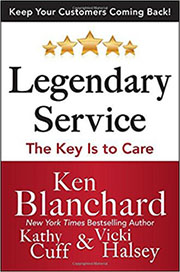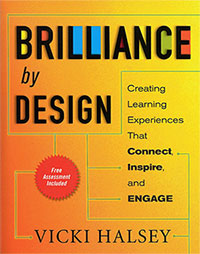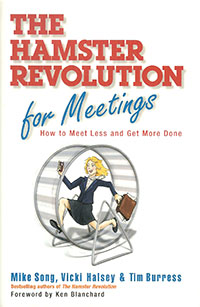“Don’t forget managers are key to creating a culture of service,” says Vicki Halsey, coauthor with Ken Blanchard and Kathy Cuff of the book Legendary Service: The Key is to Care. “Managers are directly responsible for translating a customer service vision into the goals and tasks frontline service providers need to focus on and be appreciated for.”
Halsey points to some natural connections between The Ken Blanchard Companies’ flagship training program, Situational Leadership® II (SLII®), and the newly released Legendary Service® training program:
Set clear goals. “Goal setting is a key component of both our Legendary Service and SLII program offerings,” explains Halsey. “We are firm believers that, at both the organizational and individual level, all good performance begins with clear goals. In Legendary Service training, we teach the importance of having clear organizational and individual service visions. This spells out who you serve, how you do it, and what the benefit is to the customer. In our SLII training, managers learn how to take organizational goals—such as a customer service vision—and turn them into meaningful individual goals and tasks that inspire direct reports.
“With both programs, managers need to be as clear as possible about what a good job looks like. This can be a little more difficult than it seems on the surface—for example, when there are conflicting priorities. Managers are often asked to hit output quotas at a high-quality level and under a certain budget. In a call center, this might translate into solving each customer’s problem the first time, with current staff who must maintain a call volume of more than 20 calls answered per hour. That can be a challenge. The best organizations get clear on what is most important and set specific, trackable, and attainable goals while maintaining motivation and avoiding burnout.”
Once goals are set, be attentive. In Legendary Service training, Halsey teaches the importance of attentiveness—focusing your attention on the needs and wants of the customer. In SLII, the focus is on the needs of the direct report who is working with the customer.
“You have to treat your people the way you want them to treat your customers. In Legendary Service, we teach people how to uncover the spoken and unspoken needs customers bring to the interaction. We teach service personnel how to ask questions, actively listen, and confirm that they understand what the customer is looking for. In SLII, we teach managers how to be attentive to their employees’ needs by diagnosing their development level on a specific goal or task. From there, the manager can offer different levels of direction or support.”
Halsey explains that most organizations don’t give managers the time to properly diagnose an employee’s level on a given task. Instead, they use a tell-and-do approach. “Managers simply assign tasks such as, ‘Be sure to ask each customer if they’d like to sign up for a credit card, you must maintain a certain call volume, or process a certain amount of claim forms.’
“What’s missing is the manager taking the time to assess each employee’s development level on each task. Is it new to them? Have they done it before? Are they committed to it? Or are they just going through the motions?”
Be situationally responsive. “Every new task requires an assessment of an individual’s competence and commitment to carry it out successfully. If the person is new to the task, you have to respond by providing direction. If their commitment isn’t there, you have to focus on providing support and rationale.
“In Legendary Service, this is taught as being responsive to customers by acknowledging feelings, offering solutions, and gaining agreement. The goal here is to treat the customer the way they would like to be treated—the Platinum Rule,” says Halsey. “When working with direct reports using SLII, this means identifying the amount of direction and support the direct report needs on that task and then gaining agreement on providing it.”
“This part is critical,” explains Halsey. “If we don’t diagnose and we don’t use the right leadership behaviors, we are not giving people what they need to serve customers at the highest level. As managers, we are not modeling a serving mindset.”
Be empowering. Empowerment is the final element in the Legendary Service model—and it is all about teaching people to take initiative, ask for the help they need to succeed, or to share innovative ideas.
“You want to help people step into their power,” says Halsey. “A big part of that is taking a look at the policies, processes, and procedures being used in your organization. Are they helping your people serve your customers or getting in the way?”
Managers must take a measured approach, says Halsey. “Empowering isn’t about delegating the responsibility for service to others. Instead, it is working together to set a service vision, providing training on being attentive and responsive to customers, and then consistently asking for ideas on how to improve the process.
“There is a big difference between telling someone what to do versus teaching them how to do it. It’s taking the time to identify what needs to done and then taking the time to diagnose development level of both internal and external customers and provide the direction and support people need to succeed.
“As a manager, you have to make a conscious decision to slow down and discover where your people are through skillful questions and listening. Then you have to show you care by adjusting your style to respond in a way that provides what they need.”
“It all adds up to showing people you CARE—you are Committed to service, Attentive, Responsive, and Empowered,” says Halsey. “It’s a great model for creating a service culture internally with your direct reports—as well as externally with the people who purchase your products and services.”
Would you like to learn more about combining Legendary Service and Situational Leadership® II to create a culture of service inside your organization? Join us for a free webinar on May 23!
 Taking a Top-Down, Bottom-Up Approach to Service in Your Organization
Taking a Top-Down, Bottom-Up Approach to Service in Your Organization
Wednesday, May 23, at 9:00 a.m. Pacific Time
In this webinar, Dr. Vicki Halsey, coauthor of The Ken Blanchard Companies’ new Legendary Service program, will show you how to take a top-down, bottom-up approach to customer service that will engage everyone in your organization.
Vicki will show participants how to apply Legendary Service concepts to create a customer mindset for all associates in the company, and then layer on an additional level of training for managers with SLII to bring the learning full circle.
Participants will learn:
- How to apply Blanchard’s 4-step CARE model (Committed, Attentive, Responsive, Empowered) to interactions with internal and external customers in a way that improves teamwork, collaboration, and performance
- How leaders can supercharge performance by improving their goal setting, day-to-day coaching, and performance management skills using SLII principles
- How to turn the organizational hierarchy upside-down so that everyone is focused on serving customers first
Don’t miss this opportunity to create an organizational culture that is aligned, integrated, and focused on the customer!
[ Source: https://humancapitalleague.com/you-cant-create-a-culture-of-service-without-manager-support/ ]






